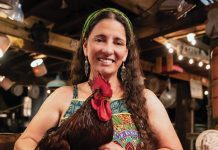Just 20 minutes before Marco Fermin was about to do the craziest thing he’d ever done, the power went out.
That’s not abnormal in the Dominican Republic. But Fermin would’ve liked to have the lights on for what was coming next. Quitting, though, that wasn’t something Fermin did. Besides, if he turned back now, if he walked away from this little Santo Domingo clinic, that cancer growing in his back might finally kill him.
He was on his stomach, the exam table paper crinkling below him. Over on a counter nearby, a cauldron bubbled away. Inside were needles, just like the one the doctor was now holding. The clinic must have been reusing them.
What happened next went down in a blur. The doctor stuck the needle into a small bump on Fermin’s back, just above his tailbone.
Fermin had a cancerous tumor stuck to his spine. He had known it for a year.
The South Florida doctor who told him about it said Fermin needed surgery. It would leave him at least partially paralyzed. Fermin was going to try everything he could before he’d let that happen.
When the doctor in the sunlit Dominican clinic pushed on the needle’s plunger, it felt like a pocket knife jammed into Fermin’s spine. Inside the needle was ozone. The Dominican clinic promised it would kill the cancer. Ask doctors in the states about ozone treatments for cancer and they’ll tell you it can kill patients instead of cure them.
The doctor moved the needle around and pressed on the tumor. There was so much pain Fermin couldn’t focus on anything else, the doctor, the lack of lights, the needles boiling away.
All of it might sound mad to you and me. But for Fermin, it was just another wild step in his battle to fight the tumor chewing away at his back. It would all end with a dangerous and perhaps record-breaking surgery. And it would end, just like it all began, with Fermin fighting.
That’s sort of Fermin’s thing, fighting. He learned it growing up in the Bronx and Jersey City, where every walk to school meant a possible fistfight. He’d go see friends by going up to the roof of his apartment building and jumping the alley, all to avoid the drug dealers on the street corners below.
After high school, Fermin worked as a club bouncer. That’s how he got spotted by hip-hop stylist Derek Khan. As Khan’s bodyguard, Fermin saw life outside the hood for the first time. He wanted more. He got a degree as a personal trainer and landed a job at the David Barton Gym in Manhattan.
Fermin had the cash from his first paycheck in his hand when a thief approached him at the train station. The kid held a .38-caliber snub nose revolver. Fermin punched him in the face. It didn’t stop the thief from firing.
The bullet pierced Fermin’s heart. He survived anyway, and four days later he was hobbling out of the hospital.
He moved to Florida and crawled his way up the gym scene. He trained fighters in mixed martial arts, and by 2008, Fermin had opened three of his own gyms.
Always meticulous about his own body, Fermin was a walking ad for his gyms. Six percent body fat, he’d boast, on a six-foot, 187-pound frame. Comic book artists could have taken inspiration from his muscles.
He was playing basketball on Oct. 28, 2008, when he came down from a layup and felt a pain in his back. It hurt just a little at first, but later it was doubling him over in pain.
Ten hours passed at the Jackson Memorial ER before somebody finally paid attention to the guy with back pain. A technician looking over Fermin’s X-ray gave him a clue of what was coming when she said, “Oh, that’s not supposed to be there.”
A doctor told him it was a sacral chordoma, a cancerous tumor in his pelvic area. There’s no telling why it formed. It would be hard to find someone healthier than Fermin. Maybe genetics, maybe environment, maybe a combination of both left him with the golf-ball-sized tumor that had weaved its way into his spine.
Surgery would likely save his life, but he’d never walk again. And he’d be using a bag to go to the bathroom. “We’re going to get you on disability,” the doctor said. “We’ll set you up.”
No. Fermin could not resign himself to life in a wheelchair. He would not be on disability. He would do the only thing he ever did, and he would fight.
He started with a juice cleanse for 20 days. Then a vegan diet. He added twice-a-day Epsom salt baths. Through all of it, he was getting weaker.
So he took a wild, around-the-world trip through experimental medicine.
Brazil was first. That’s where he met a man in early 2009 who called himself a naturalist doctor, although his license to practice medicine had been long gone. Take escoazul, the man told him, otherwise known as the venom of a blue scorpion. Fermin paid $700 for each ounce of the stuff. It did nothing.
He flew to Japan. The university in Hyogo was experimenting with a new form of radiation therapy. The doctors told Fermin he didn’t qualify for the tests. No explanation why – they just sent him away. He lost thousands on the trip, but more than anything, he was losing time.
The tumor had grown to the size of a peach, and he was in constant pain. He could no longer sit down without a crippling throb. Lying down on his back was impossible.
That’s when he tried the ozone injection in the Dominican. At that point, he was desperate and angry, and the clinic promised the $3,000 injection would cure him.
After the pain subsided from the ozone shot, Fermin noticed something about his tumor. It was receding. Within days, he could no longer feel the bump. The pain was gone. He went back to work. He went back to training MMA fighters. He was telling people about how the ozone had cured him.
Six months passed before the bump on his back came back. It just popped up one day, maybe bigger than before. It hurt even more this time, and now Fermin could not lay down at all, even on his stomach. Soon, the only way he could sleep was by taking naps kneeling face first into a chair.
Chlorine treatment came next in early 2011, and that was the worst of them. All the promises by the woman he met at church amounted to nothing. The chlorine did nothing but make him violently sick, and he could literally feel the tumor growing. It would get hot as it ate the tissue around it.
Over four months time, Fermin dropped 30 pounds. You could see the outline of his skeleton in his face, through his arms, poking out of his bony knees. He was at 128 pounds, and a rumor spread that he had AIDS. He went from 276 active clients to less than 40. It had taken him nine years to build up his business, and now it was done.
He moved in with his older brother, Francisco Fermin, in Plantation. His health deteriorated fast then. Fermin lost control of his bowels, and his left leg suddenly didn’t work. He could walk only with crutches.
Francisco wasn’t going to watch his brother waste away. He told Fermin he was taking him to breakfast one Sunday morning in January 2012, but instead he drove him to the ER.
By then, the tumor was the size of a basketball.
Broward Health Medical Center called in Dr. Christopher Roberts to take a look. The neurosurgeon hadn’t ever seen such a large sacral chordoma.
Maybe nobody has. While there are no official accounts kept of such things, the growth that had nearly killed Fermin is believed to be the largest spinal tumor ever recorded.
Fermin still wasn’t sure about surgery. He would maybe just prefer to die on his own than give up the use of his legs. He told Roberts all that he had done to fight.
“This is a tough one, the toughest I’ve ever seen,” Roberts told him.
The doctor walked through what he’d need to do to remove the tumor. It would take hours and a surgical team of several doctors and multiple nurses. Roberts made no promises, but there was something about him that Fermin trusted. Fermin had found his first ally in the fight.
Roberts knew the surgery would be a marathon. It would mean multiple incisions. Many doctors would need to work together. And after all of it, Fermin’s weakened, withered body would have a tough time recovering from it.
The surgery began about a month after Fermin had first met with Roberts. Mid-morning Feb. 26, 2012, at Broward Health, Roberts began with a large incision in Fermin’s back. Then he sliced through tissue along the sides of the tumor. He would need to not only remove all of the cancerous tissue but make sure none of it fell. If any part of the cancer was spliced off and left behind, it would grow again.
It took Roberts five hours to cut around the bony tumor. Then he drilled through it and to the other side, where he could cut nearly to Fermin’s stomach. Seven pounds of tumor in all were carefully lifted away – as heavy as a newborn.
Now Fermin’s body would need to be rebuilt. Roberts used titanium to repair missing pieces of pelvis and spine. Then he turned his attention to the nerves. The tumor had damaged nerve connections to Fermin’s entire lower half, controlling his legs, bladder, and digestive tract. If Roberts failed in this next tedious part of the surgery, Fermin would be using a bag to go to the bathroom for the rest of his life. And he’d never walk again.
Nerve reconstruction is tedious, like splicing together a series of phone lines running through the body. It’s an area of surgery that holds uncertainty. Even as Roberts reconnected the damaged nerves into Fermin’s spinal cord, he knew that they simply might not take, that Fermin’s body might reject them, or the lines just wouldn’t make a connection to his brain.
Eight hours in, Roberts closed up the wound. But there was still so much more to be done. They flipped Fermin over and now cut into his stomach.
Roberts took his first break. He had gone eight hours straight. “You don’t really think about the fact that you’re hungry or tired in the middle of it,” Roberts says. “You just have these jobs to do, so you keep moving.”
Two plastic surgeons used muscles from Fermin’s stomach to replace tissue missing in his back. A general surgeon stepped in, securing Fermin’s colon and using mesh to fill the now empty cavity where the tumor had been.
By the time Fermin’s two incisions were sealed up, 16 hours had passed. It had all gone just as Roberts had planned. The tumor was out, the spine rebuilt, and the nerves all seemed to be in order.
The whole thing now rested on Fermin’s ability to fight it. “Fermin was emaciated from this thing. It had nearly taken the life out of him,” Roberts says. “No matter how good the surgery went, he still had a long way to go.”
They woke Fermin up 48 hours later. Roberts wanted him to try out his legs. Fermin swung them over the side of the bed. One foot down, then the other. He put weight on them. And then a step. And another.
Months of rehab followed. He’d need to learn how to walk again, and it would take a long time before his rewired bowels would work on command.
Earlier this year, he moved into a small apartment. A ground-floor unit was available, but Fermin, now 39, opted for one on the second floor, just to push himself harder. One morning in March, he finally made it up the stairs without using the railing.
He has a brace on his leg and walks with a slight limp, but otherwise you’d never know what he went through. He’s back in shape, and he has begun training MMA fighters again.
“I know this is weird, but I feel like the whole thing was necessary,” Fermin says. “I was living selfishly before. It was all about cars and money and things. I was not thinking about family before. That’s all I think about now.”
He’s taking classes to start a career in advertising. He’s hoping to be done with training fighters by the end of this year. He imagines opening up his own advertising studio, making commercials and building media campaigns.
For Fermin, whether he’s in the ring or crafting a campaign, he’ll always be a fighter.
Cancer: By the Numbers

100+ types of cancer
232,670 new cases of invasive breast cancer expected this year
13 percent of cancer diagnoses are lung cancer
1.8 percent increase per year in rates of colorectal cancer in adults under 50
23,720 persons in the U.S. will die of leukemia in 2013
– M.B.











Facebook Comments